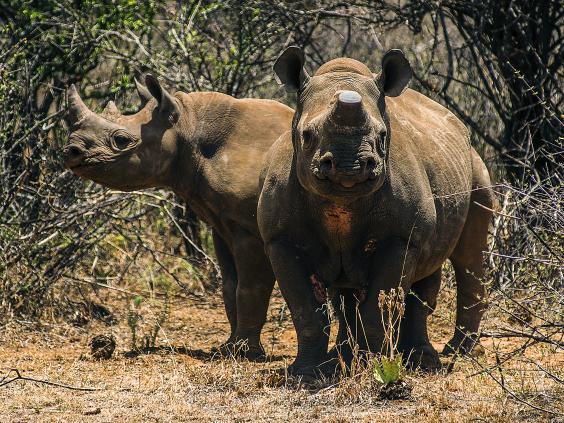The Kenyan comeback of the Black Rhino
How one wildlife conservancy is defying the odds - using technology, cattle ranching and community buy-in - to grow and protect its endangered rhino population

Your support helps us to tell the story
From reproductive rights to climate change to Big Tech, The Independent is on the ground when the story is developing. Whether it's investigating the financials of Elon Musk's pro-Trump PAC or producing our latest documentary, 'The A Word', which shines a light on the American women fighting for reproductive rights, we know how important it is to parse out the facts from the messaging.
At such a critical moment in US history, we need reporters on the ground. Your donation allows us to keep sending journalists to speak to both sides of the story.
The Independent is trusted by Americans across the entire political spectrum. And unlike many other quality news outlets, we choose not to lock Americans out of our reporting and analysis with paywalls. We believe quality journalism should be available to everyone, paid for by those who can afford it.
Your support makes all the difference.When it comes to rhinos - and elephants – it’s usually bad news. Rampant poaching across Africa and Asia has wiped out national populations, driven several subspecies to extinction and fuelled the operations of international criminal cartels.
In the face of this however, one conservancy in Kenya has managed to grow its population of endangered black rhinos by 100% in just 10 years. Using this as leverage for eco-tourism, the approach has brought community and conservation together by implementing sustainable agriculture, and creating health and education programmes.
Their success has lead to a dilemma few at Ol Pejeta Conservancy ever dreamt of – they are fast approaching the maximum number of black rhinos that the 90,000-acre conservancy can sustain. This is a challenge that is catalysing new partnerships, and presenting a window to a future for wildlife conservation across Africa.
Ol Pejeta Conservancy is nestled in the foothills of Mt. Kenya, in the wildlife-rich Laikipia County. When it was first established as a rhino sanctuary in 1989, it was home to just four black rhinos. Today, it is the largest black rhino sanctuary in East Africa, and hosts approximately 16% of the national population. Recently, Ol Pejeta was the host to delegates from the Giants Summit in recognition of its incredible contribution to conservation globally.
Its elite anti-poaching squad includes a K-9 unit, with attack and scent detection dogs trained to locate ammunition, ivory and rhino horn. The rangers ensure each rhino is visually observed at least once a week.
But it is their arsenal of wildlife monitoring technology that impresses. Infrared camera traps set up along a solar-powered electric fence provide 24/7 surveillance and their more recent deployment of drones is an innovation to conservation that is fast becoming irreplaceable.
While technology is now a big part of the Conservancy’s success, it is also its investment in surrounding communities that has lead to overwhelming local support for wildlife conservation from the people living along the Conservancy’s borders.
Whilst the bulk of revenues are derived from tourism (Ol Pejeta has currently has 170 beds in 7 camps/lodges), over the last 10 years Ol Pejeta has proven that an integrated system of wildlife and livestock management not only works, but can actually be beneficial to the grasslands at the same time as helping to maximize land productivity.
This commercial (but totally sustainable) approach is allowing Ol Pejeta to reinvest US$ 600,000 into community development projects in 2017. From developing green energy for homesteads, to establishing ICT hubs in secondary schools and supporting mobile health clinics in rural villages, Ol Pejeta has ensured the benefits of conservation are seen where they are needed the most.
In turn, local people work closely with the conservancy security teams – providing intelligence and reporting suspicious activity. This has been an invaluable asset not only in anti-poaching operations, but also in helping to reduce other crime in the area.
In 2012, the Kenyan Government set aside 20,000 acres of agricultural land bordering Ol Pejeta for integrated wildlife, livestock and tourism use. Ol Pejeta now manages this area in collaboration with local communities, in a move that sees a private and public sector partnership working to maximise the productivity of the land, providing new black rhino and wildlife habitat at the same time.
“This is the future of conservation” says Ol Pejeta’s CEO Richard Vigne; “finding ways to secure habitat in a manner that maximises productivity, benefits human beings and safeguards wildlife populations for posterity”
You can find out more about this innovated approach to wildlife conservation at the Wild World of Rhinos ‘Their Moment of Truth' event in London on 23rd March, hosted by Ol Pejeta and their UK partner Helping Rhinos. Richard Vigne will be speak, alongside well known television wildlife presenters Simon King (BBC Big Cat Diary) and Giles Clark (BBC Ingenious Animals). Details at helpingrhinos.org
Join our commenting forum
Join thought-provoking conversations, follow other Independent readers and see their replies
Comments